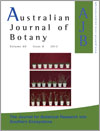Australian Journal of Botany
Volume 60
Number 8 2012
A novel nurse-pot system was used to investigate the extent and temporal colonisation dynamics of jarrah (E. marginata) by two arbuscular mycorrhizal (AM) and two putative ectomycorrhizal (ECM) species. Mycorrhizal colonisation increased with time for the test seedlings exposed to hyphal networks from AM species. The ECM isolates dominated the growth and nutritional benefits regardless of their colonisation capability, but ECM were apparently suppressed when AM were present in dual culture.
Acacia dealbata Link (Mimosaceae) cause serious environmental problems in north-western Spain threatening native-plant biodiversity. We found significant effects of invasion status on species richness, plant density and total plant cover; values were significantly lower in invaded than non-invaded patches. Results suggest that A. dealbata represent a serious threat to all of the study communities, the severity of the impact being dependent on the community type.
In the present study, physiological growth, leaf water status and carbon isotope discrimination values were reduced in adult plants of cocksfoot (Dactylis glomerata), perennial ryegrass (Lolium perenne) and common sorrel (Rumex acetosa) exposed to the phytochemicals benzoxazolin-2(3H)-one and cinnamic acid at 0, 0.1, 0.5, 1.0 and 1.5 mM concentrations.
The objective of the present study was to evaluate the role of epicuticular wax in gas exchange, leaf water relations and some leaf biochemical parameters of Jatropha mollissima (native) and Jatropha curcas (exotic) under mild water deficit. The results showed very fast wax synthesis in native species, and increased transpiration rate in leaves without wax under water-shortage conditions.
In mature seeds of Smilax polyantha, the cellularised endosperm has thick-walled cells, the embryo is small and the tegmen comprises two layers of periclinal elongated cells with a red–orange content, which are covered by a cuticle. Endosperm chemical analyses detected hemicellulose, glucose, mannose and galactose. Delayed seed germination in S. polyantha is associated with the seed endosperm cell walls.
Leaf morphology and leaf cuticular characters are used to reconstruct past temperatures and CO2 concentrations from leaf fossils. This relationship may be confounded by changes in relative humidity as we found that leaf size and shape of Nothofagus cunninghamii are significantly altered by changes in humidity. Stomatal density and stomatal index did not respond in any systematic way to humidity. Thus, cuticular fossil signals from this species, unlike those from gross leaf morphology, are unlikely to be affected by variation in humidity.
In this paper we have classified and described the following three new colleter types: petaloid, conic and euryform from 52 species belonging to 17 genera from seven tribes of the subfamily Myrtoideae (Myrtaceae). The tribe Eucalypteae was unique in that we did not find any colleters in the species analysed. The colleters in Myrtoideae may help clarify the phylogenetic relationships of the Myrtaceae family.
Microsatellite markers were used to investigate the population genetic structure of the endangered tetraploid shrub, Allocasuarina emuina. No relationship was found between the level of genetic variation and population size, density or degree of isolation, however genetic signatures in lowland populations surrounding the putatively refugial population on Mt Emu indicate a unidirectional dispersal of genetic material as sea levels have receded.
The height of a rain forest tree determines its position in the canopy, regulates access to light and is bounded by species maximum potential height at maturity. Rain forest communities vary in height relative to factors such as soil depth and exposure, and shifts in the performance of co-occurring species can occur under differing conditions of environment. Understanding how different species in communities respond to shifts in environmental conditions provides important insights into the ecological processes that influence community assembly.
In contrast to Arabidopsis, a related species, Thellungiella halophila, displays extreme tolerance to high salinity, low humidity and freezing, and is considered to be a valuable model for abiotic-stress research. The aim of the present research was to determine optimal parameters for seed vernalisation and photoperiod of T. halophila. Plants growing from seeds that had been vernalised (4°C) for 30 days and with daylengths >9 h had maximal flowering and the shortest life cycle.




